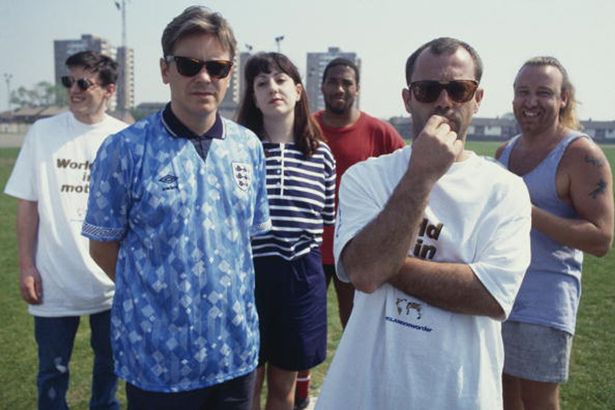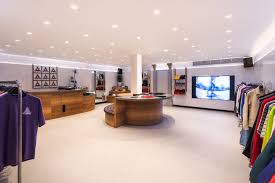
British brands don’t get much bigger than Palace. Their rave inspired sports and skatewear has been turning heads since 2009, with suburban teens, Hip Hop legends and tennis players all sporting the label’s authentic fabrics and wavy designs. Cues reach around the streets of Soho whenever Palace even hint at a clothing drop, making it difficult to remember where the chaos started. What were the turning points for Palace? How did a dream made on Southbank get the right to challenge fashion heavyweights Supreme and find a corner in Dover Street Market?
The man behind the madness is Levi Tanju - an ex-skater with an impulsive personality and an eye for fashion. Originally, he only had one business plan; Tanju asked a clothing factory ‘can you make the logo as big as it will go on the back of the shirt, as far as the seam will allow’. The prominence of the 'Tri-Ferg' logo in today’s world is undeniable. It has been used politically by another brand called ‘hype peace’ to raise money for the Palestinian cause, but also in collaborations with sportswear giants like Umbro, reimagining England’s famous Italia 90 football Jersey - a piece now worth over £250.00.

Palace’s authenticity is the key to their success. To its core, it’s a skater brand; ran by skaters and brought mainly by people who embrace the skating culture. Originally, the label was made to sign promising talents Blondey McCoy, Lucien Clarke, Chewy Cannon and Benny Fairfax, who are now all modern day urban idols and the faces of Palace. Charlie Young, Danny Brady, Shawn Powers, Olly Todd, Torey Goodall, and Rory Milanes all deserve mentioning too and often feature as unlikely models in the lookbooks; Tanju continues to use them for the comedic vibe he cherishes.
It is also worth noting that 21 year old Blondey McCoy now has his own successful brand, ‘Thames’, which is named after the River that sits parallel to the famous Southbank skatepark the Palace crew all met. London’s iconic skating haven is also nicknamed ’the Palace’ and Tanju and his crew became jokingly named as the ‘Palace wayward boy’s choir’ when they would go to houses squatting in Waterloo. There therefore couldn’t really be a name more suitable for the clothing Levi wanted to create.
The man of Turkish descent started to establish his brand by flipping the aesthetic of skater videos; when crews were warming towards HD 1080p film, he was pursuing a 90s VHS style. This was seen as incredibly unique, and has influenced the visuals of many other brands, most notably Places + Faces. In 2011, even the biggest of stores were starting to warm to Palace, Supreme opened up their first European shop and refused to stock any other labels bar themselves and Palace; Lucien Clark also modelled their FW11 lookbook. This provoked Palace to start opening pop up shops of their own, which they called the ‘Palace Retail Powerslide’. Labelling their staff as ‘fully untrained’, the brand’s slacker outlook on life and ironic success has led to frequent collaborations with sportswear giants, like Umbro in 2011. This collection was a celebration of the 90s, they illustrated the pub culture, football fever and underground electronic music scene that was so apparent in this era.

They’ve gone on to have collections with Adidas, Reebok and Oakley sunglasses; expect many more over the coming years. To promote these collaborations, Tanju and co have directed many comedic commercials, featuring the likes of Jonah Hill, who is a long time wearer of the brand.
By 2013, Lev and his merry men were putting on skate inspired exhibitions at the Tate modern, and collaborating with the historic art space too. Their cult following were snapping at the heels of every stockist, and causing their disfunctional website to crash on every release. The artist that Tanju modelled the decks on was John Martin; ‘the great day of his wrath’ was just one of the many pieces of work he used, which aligned well with the utopian aesthetic Palace often pursues.
Eventually, in 2015, Palace opened up its first shop in London, just a minutes walk away from Supreme in Soho, and 5 minutes away from Dover Street Market. The interior design is a subtle nod to the Italian fashion industry. The marble flooring and greek plants are both welcoming and classy, and also a tribute to the 90s raving days when people would wear mediterranean brands like Moschino and Iceberg. They now have a store in NYC, the streetwear capital of the world, with a pissing brass cherub water fountain at the centre of the space.
LONDON
NYC
The key to Palace’s long living legacy is unarguably their logo. Within the short, but dense, history of Tanju’s internationally loved label lies his penrose triangle inspired ‘Tri-Ferg’, which was designed by graphic illustrator ‘Fergus Purcell’. The English artist had previously made logos for Stüssy and thus is well loved in the skate scene. His nickname is ‘Fergadelic’ and this is how the logo adopted the nickname ‘the Tri-Ferg’, now everyone is sporting it. From A$AP Ferg coming through the London store, to North West (Kanye’s first child) rocking a tee shirt, the brands dominance in the British fashion industry has been incredible considering its barely been a decade since it started.

Tanju’s ultimate goal was simple - make enough money so his mates can skate as much as they want and worry about as little as possible. Their AW18 collection is dropping every Friday at the moment and you can view the lookbook on their website now.











































